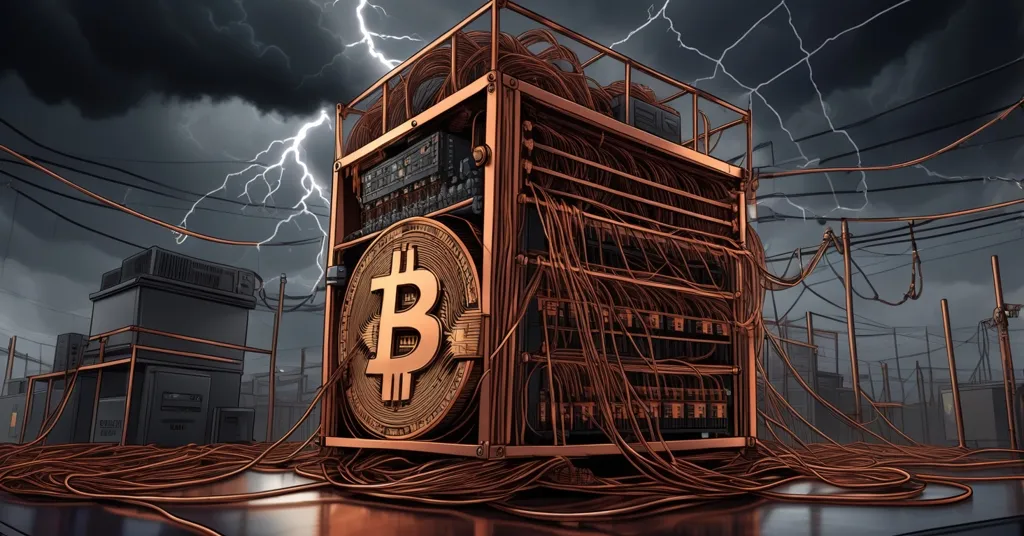Trump’s Copper Tariffs Surge Prices: A Serious Blow to Bitcoin Mining and Blockchain Tech

Trump’s Copper Tariffs Spike Prices: A Hidden Threat to Bitcoin Mining and Blockchain Tech
President Trump’s recent declaration of a 50% tariff on copper imports has unleashed a firestorm in the U.S. market, with copper prices soaring 13% in a single day to $5.69 per pound—the biggest one-day jump in over 30 years. While aimed at boosting domestic production, this policy could hammer everything from household goods to high-tech infrastructure, with a particularly nasty sting for Bitcoin mining and blockchain innovation, where copper is a silent but critical player.
- Price Explosion: U.S. copper prices surged 13% to $5.69 per pound, dwarfing the London Metal Exchange (LME) increase of just 0.3%.
- Tariff Shock: Set for late July or August 1, the 50% tariff hits nearly half of U.S. copper supply, imported from nations like Chile and Canada.
- Crypto Risk: Higher copper costs threaten Bitcoin mining operations and blockchain infrastructure, potentially centralizing power in fewer hands.
The Tariff Breakdown: A Policy with Bite
Trump’s announcement, rooted in his “America First” push to cut reliance on foreign goods, targets copper imports that make up roughly 50% of U.S. consumption, sourced largely from Chile, Canada, Mexico, and Peru. The immediate fallout saw the U.S. Comex market—a key domestic commodities exchange—record a staggering premium of $2,600 per ton over global LME prices, up from a modest $150 per ton last year and a range of $500-$1,500 since February. Analysts at Benchmark Mineral Intelligence warn that if the tariff rolls out as planned by August 1, as hinted by Commerce Secretary Howard Lutnick, U.S. copper could hit $15,000 per metric ton against a global benchmark of $10,000. That’s a brutal markup for a metal woven into nearly every corner of modern life.
For those new to commodities, the LME (London Metal Exchange) sets the global standard for copper pricing, while Comex reflects U.S.-specific trends. This price gap means American businesses and consumers are paying a steep penalty compared to the rest of the world, with no immediate relief in sight. Lutnick himself pegged the start date around late July or early August, but the market isn’t waiting—prices are already climbing, and the economic tremors are spreading fast.
Economic Fallout: From Fridges to Freeways
The ripple effects of this tariff are hitting hard and wide. Copper is a foundational material in everyday items—think wiring in your car, circuits in your fridge, or coils in your air conditioner. Daan de Jonge, head of copper pricing research at Benchmark Mineral Intelligence, didn’t hold back on the consumer impact:
“If you’re buying a new fridge, air conditioner, car; everything is going to get more expensive.”
That’s not speculation; it’s basic math. With costs spiking, as seen in the recent copper price surge, manufacturers are either eating thinner margins or passing the burden onto buyers. Beyond households, national infrastructure projects—roads, bridges, power grids—are staring down delays or outright cancellations as budgets buckle under the weight of inflated material costs. De Jonge also flagged the risk of “employment effects,” meaning job losses could follow as businesses cut back. Even worse, he pointed to “demand destruction”—a term for when prices get so high that industries just stop using the stuff, potentially tanking entire sectors that rely on copper.
While these impacts are broad, they set the stage for a more specific threat to our focus: the tech-driven, decentralized future that Bitcoin and blockchain represent. Before we get there, though, let’s unpack why the U.S. can’t just dig its way out of this mess overnight.
Domestic Production: A Pipe Dream?
The logic behind the tariff is to supercharge American copper mining, but the reality is far messier. Peter Chase, a senior fellow at the German Marshall Fund, laid it out plain and simple:
“The price of copper with a 50% tariff is not going to mean copper production in the U.S. goes through the roof tomorrow.”
That’s putting it mildly. Scaling up domestic mining isn’t like firing up a new Bitcoin node—it’s a slog of years, if not decades. We’re talking billions in investment, regulatory red tape, and environmental pushback that could stall projects before they even break ground. Look at past tariffs, like the 2018 steel duties under Trump: prices spiked, sure, but domestic output barely budged due to structural hurdles. Copper faces the same wall. For now, the U.S. is stuck shelling out premiums while praying for a miracle that’s nowhere near.
Adding skepticism to the mix, not everyone believes this tariff will even stick. Chilean President Gabriel Boric has expressed doubts, awaiting official confirmation, while Derek Holt of Scotiabank slammed the policy as economically nonsensical, burdening American consumers for negligible gain. Markets reflect this uncertainty—while U.S. prices jumped, as noted in reports on tariff-driven copper costs, global reactions remain tepid, with some betting on exemptions or a policy reversal. Still, even the threat is enough to disrupt supply chains and jack up costs.
Bitcoin Mining Under Pressure: A Decentralization Dilemma
Now, let’s zero in on why this tariff is a red alert for us Bitcoin maximalists, blockchain advocates, and decentralization warriors. Copper isn’t just a commodity; it’s the lifeblood of the data centers and energy systems that keep Bitcoin mining rigs humming. Those server farms—packed with ASIC miners solving complex math puzzles to secure the network—rely on extensive copper wiring for electrical conductivity and cooling systems to prevent overheating. A single mid-sized mining operation can use thousands of pounds of copper in its setup, from power cables to heat sinks. With prices potentially climbing to $15,000 per metric ton, operational costs for U.S.-based miners could spike by 20-30%, a gut punch to smaller players already scraping by on thin margins, as discussed in analysis of tariffs on mining infrastructure.
For the uninitiated, Bitcoin mining is the process of validating transactions on the network by solving cryptographic puzzles, a power-intensive task that rewards miners with newly minted BTC. It’s the backbone of Bitcoin’s security and decentralization, ideally spread across countless independent operators worldwide. But when costs soar—like they might under this tariff—smaller miners get squeezed out, leaving the game to deep-pocketed corporations or foreign entities in cheaper regions like Kazakhstan or China. That’s not just a business problem; it’s a direct assault on Satoshi Nakamoto’s vision of a network free from centralized control. Ironic, isn’t it? A policy pitched as breaking global dependency might just chain Bitcoin’s hash power to a handful of big dogs.
Let’s play devil’s advocate for a moment. Could this cost crunch spark innovation? Maybe miners pivot to energy-efficient hardware or decentralized mining pools that share resources. Some might even explore off-grid setups, aligning with the rugged, self-reliant ethos we admire. But let’s not kid ourselves—such solutions are a long shot compared to Bitcoin’s core resilience, and they don’t erase the immediate risk of centralization. This tariff isn’t just a line item on a balance sheet; it’s a stress test for the distributed future we’re fighting for.
Broader Blockchain and Tech Impacts: A Ripple Beyond Bitcoin
The pain doesn’t stop at Bitcoin. Blockchain tech, often intertwined with artificial intelligence (AI) for decentralized computing protocols like Fetch.ai or SingularityNET, is equally copper-dependent. Data centers powering these innovations need the same wiring and cooling infrastructure as mining rigs. A price surge could slow the rollout of new blockchain applications, especially for startups already battling high upfront costs, a concern echoed in discussions on blockchain infrastructure challenges. Even altcoins like Ethereum, which ditched energy-hungry Proof-of-Work for Proof-of-Stake, aren’t immune—their ecosystems still rely on physical servers for nodes and dApps, niche areas where Bitcoin doesn’t play but innovation thrives.
Globally, the tariff’s timing is a disaster for U.S. tech ambitions. As Mexican President Claudia Sheinbaum and Chilean President Boric hint at redirecting copper exports to China—a massive copper consumer already—the balance of supply chain power could tilt. Pierre Gratton of the Mining Association of Canada warned this policy might hand China a strategic edge while U.S. manufacturers and tech firms bear the cost. If China stockpiles redirected copper, it could dominate production of mining hardware and blockchain gear, raising privacy and decentralization concerns for a community already wary of centralized choke points. It’s a bitter twist: a tariff meant to protect American interests might empower a rival with little love for crypto’s borderless ideals.
Key Questions Answered for Crypto Enthusiasts
- How do Trump’s copper tariffs impact U.S. prices?
U.S. copper prices rocketed 13% to $5.69 per pound in one day, with forecasts of $15,000 per metric ton if the tariff hits by August 1, far above global rates. - What does this mean for everyday consumers?
Expect higher costs for goods like cars, fridges, and appliances, alongside delays in infrastructure projects due to ballooning material expenses. - How do copper tariffs affect Bitcoin mining costs?
Rising copper prices could inflate operational costs for U.S. miners by 20-30%, pricing out smaller operators and risking network centralization, as explored in community discussions on mining impacts. - Can domestic production offset these tariff impacts quickly?
Not a chance—experts say scaling U.S. copper mining could take decades, with huge financial and regulatory barriers in the way. - Are there wider risks to blockchain and decentralized tech?
Yes, cost hikes threaten blockchain infrastructure and AI-driven protocols, while global supply shifts to China could impact hardware access and privacy, a topic raised in forums on copper and blockchain tech.
Geopolitical Fallout: A Global Chess Game
Beyond tech, this tariff is stirring a geopolitical hornet’s nest. Chile and Mexico, key U.S. copper suppliers, aren’t sitting idle. Sheinbaum’s readiness to pivot exports elsewhere—likely to China—mirrors Boric’s wait-and-see stance, both signaling that the U.S. might not hold all the cards. If these nations redirect supply, China could tighten its grip on critical materials, indirectly influencing everything from blockchain hardware to mining equipment production. For a community obsessed with sovereignty and freedom, that’s a chilling prospect—imagine a future where your rig’s components are at the mercy of a state hostile to crypto’s ethos, a risk highlighted in news on retaliatory trade actions.
This isn’t just hypothetical. China’s already a juggernaut in tech manufacturing, and copper is a linchpin. A trade shift could exacerbate existing tensions, especially as the U.S. pushes for tech independence while shooting itself in the foot with policies like this. It’s a stark reminder that decentralization isn’t just about code—it’s about resilient supply chains immune to political gamesmanship.
A Call for Crypto Resilience
Let’s cut through the noise: Trump’s copper tariff is a sloppy, blunt instrument with no clean wins. It’s a policy that claims to disrupt global dependency but might just shackle the decentralized systems we hold dear. For Bitcoin and blockchain to thrive, we can’t let commodity shocks or geopolitical whims dictate the pace of innovation. Miners might consider alternative cooling tech or off-grid setups, while developers could push for hardware-agnostic solutions. Heck, maybe this mess accelerates the drive toward truly sovereign, effective accelerationist infrastructure—disruption as a catalyst, not a coffin.
Still, the immediate outlook is grim. Bitcoin was forged to dodge centralized control, yet here we are, watching copper costs threaten to undermine that mission. It’s on us—maximalists, altcoiners, and privacy hawks alike—to adapt, innovate, and prove that no tariff can kill the spirit of a borderless revolution. Let’s not just survive this; let’s mine through it.



